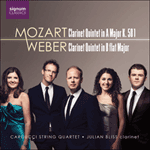
Welcome to Hyperion Records, an independent British classical label devoted to presenting high-quality recordings of music of all styles and from all periods from the twelfth century to the twenty-first.
Hyperion offers both CDs, and downloads in a number of formats. The site is also available in several languages.
Please use the dropdown buttons to set your preferred options, or use the checkbox to accept the defaults.

| Julian Bliss (clarinet), Carducci String Quartet» More |
The spacious Allegro first movement has a wealth of melodic material, and although all the themes are lyrical in character, there is no lack of contrast. Notably, most of the melodic material of this movement is first introduced by the strings. A suave opening melody for the quartet is answered in bars 7-8 by the clarinet (an upward arpeggio then descending groups of semiquavers), but the most poignant theme is the one introduced by the first violin with pizzicato cello, before being expanded by the clarinet above gentle syncopation. In the development section the clarinet phrase from bars 7-8 is taken up by each of the strings successively in the most animated passage in the movement. In the recapitulation Mozart introduces many modifications in the restatement of his original material. In the very first theme, for instance, the roles are exchanged: the clarinet now plays the melody line, the first violin the answering phrase. At the return of the flowing second theme, the clarinet restates as before, but then develops in a new direction.
The sublime Larghetto, in which the violins play with mutes, is even lovelier than its counterpart in Mozart’s Clarinet Concerto. The clarinet melody is accompanied by gently rocking quavers in violins and viola and a well-defined cello line. From bar 20 a dialogue unfolds between first violin and clarinet—the same kind of eloquent exchange which develops between solo violin and solo viola in the slow movements of the Sinfonia Concertante, K364, and the C major String Quintet, K515. In this exquisite central part of the movement ascending scales are a recurring feature above gentle suspensions. In the return of the material from the opening section Mozart adds more elaborate melodic decoration, until viola and cello respectively take over the triplet patterns for the final bars.
In the amiable Minuet, in which the five players are treated equally, forte and piano phrases alternate. Unusually, there are two trio sections, strikingly contrasted. The first, in A minor, has a violin melody of poignant melancholy, while the clarinet is silent; the second, more rustic trio (in A major) is in the style of a ländler, an Austrian country-dance.
The jaunty theme of the finale gives rise to variations encompassing a wide range of moods. In Variation 1 Mozart exploits the clarinet’s characteristic ease in moving quickly between high and very low notes, here leaping across two octaves. Whereas in a concerto the traditional orchestral passages naturally allow the soloist some necessary breathing space, this same relief must be more carefully managed in a chamber work. Thus in the second and third variations the clarinet contributes very little. Variation 2 has a first violin melody accompanied by triplets on second violin and viola throughout. Variation 3 is an eloquent lament in A minor for the viola, Mozart’s own favourite instrument when playing chamber music. This soul-searching is dispelled by the brilliance of Variation 4, with joyous semiquaver passages played alternately by clarinet and first violin. Following a serene, meditative Adagio, the work ends with a cheerful Allegro.
from notes by Phillip Borg-Wheeler © 2018
 Mozart & Weber: Clarinet Quintets Mozart & Weber: Clarinet QuintetsThe Mozart and Weber clarinet quintets are not short of recordings, but in the youthful hands of performers as skilled as these can surely be found something of the spirit of maverick adventure that must have fired their original dedicatees.» More |

